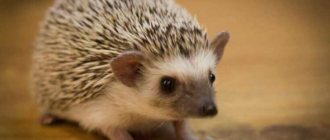Where does a hedgehog live and what does it eat? Such questions are not uncommon, because these cute animals are of interest to many.
Hedgehogs are animals of the chordate class of mammals of the order Urchiniformes of the family Urchinidae. The hedgehog has a body length from 10 to 44 cm (depending on the species), its weight can vary from 300 grams to one and a half kilograms. In addition, the animal has a tail ranging from 1 to 21 cm in length.
What does this animal look like?
The animal's large head is wedge-shaped. The muzzle is elongated, the nose is mobile, pointed and moist to the touch. A hedgehog's teeth are sharp and small. There are 20 of them on the upper jaw, and only 16 on the lower jaw. Certain species of hedgehogs have a different number of teeth - up to 44. The large first incisors vaguely resemble fangs.
The hedgehog's front legs are shorter than its hind legs. There are five fingers on each limb, except for the white-bellied hedgehog, which has four on its hind legs. Hedgehogs have long middle toes, which are used to clean their needles.
The hedgehog's spines are hollow formations, between which there is a growth of thin and sparse hairs, barely noticeable to the eye. The abdomen and head of the animal are covered with ordinary fur.
Description of the animal
A hedgehog is a small animal that feeds on insects. Its weight can reach up to 1.2 kg, and its length can be 20 centimeters. Most often, males are slightly larger than females. The hedgehog's muzzle is elongated and quite large.
The animal's eyes are small and lack the ability to see normally. But, in return for vision, the hedgehog is endowed by nature with excellent hearing and sense of smell. There are small ears on the top of the hedgehog's head, and short whiskers near the nose.
For ease of movement, its hind legs are slightly longer than its front legs. The hedgehog has thirty-six sharp teeth and long nails on each of its five fingers. These are his tools that allow him to get his food.
The main thing is needles!
The average number of needles on each hedgehog is up to 10,000, and their constant growth and renewal occurs. They are mostly dark in color, sometimes alternating with stripes of a lighter shade.
Depending on the species, a hedgehog can be brown, black, brown, sandy or even white in color. In some places, white and black colors alternate with the formation of spots. Most hedgehogs have well-developed subcutaneous muscles. A characteristic feature of these animals is to curl up into a ball when encountering danger. It is for this purpose that developed subcutaneous muscles are needed, which are located along the line of spine growth.
The hedgehog is a nocturnal animal with poor vision. As compensation, nature endowed him with excellent sense of smell and hearing. This animal cannot be called agile. The hedgehog usually runs away at an average speed of no more than 3-4 km per hour. The hedgehog is a land animal, but most of its species can swim well.
The natural lifespan of a hedgehog is about 3-5 years. If you place a hedgehog in a home environment, then in the absence of natural enemies it can live up to 8-10 years. In nature, its life is shorter. In the forest where the hedgehog lives, he becomes the object of hunting by foxes, wolves, owls, badgers, ferrets, mongooses, jackals, hyenas, eagles and many other predators. And even in the conditions of, for example, a city park, his life is full of dangers.
Where do hedgehogs live in summer and winter?
Their habitat can be considered quite wide. These small prickly animals can be found in any European country; they are found in abundance both in Russia and in much hotter Africa. Hedgehogs also live in the Middle East, New Zealand and Asia.
The places where the hedgehog lives in nature are deserts, forests, steppes, and cultivated landscapes. Even urban areas are no exception. When setting up a home, he digs a hole under the roots of a tree or in the bushes. Sometimes you can find an abandoned rodent hole where a hedgehog lived.
Hedgehog lifestyle
The hedgehog by nature itself is conceived as a solitary nocturnal animal, whose lifestyle is rather secretive. Usually in the mink where the hedgehog lives (its length can reach 1 meter), he sleeps throughout the day. Those populations that live in foothill areas can hide in voids under stones and crevices between rocks.
In the area near the burrows where hedgehogs live, they go out to hunt at night in the summer. Unfortunately, according to statistics, a very large number of them die under the wheels of cars when trying to cross roads in the dark.
What do hedgehogs eat in the wild?
They are omnivores. Their diet consists of insects, spiders, beetles, earwigs, caterpillars, slugs, earthworms and woodlice. The hedgehog will not refuse to try a toad, locust, crustacean or bird eggs. The population of hedgehogs living in the north readily eats small rodents (mice, etc.), as well as frogs and lizards.
Representatives of hedgehogs are quite resistant to any poison, even very toxic ones. That is why hedgehogs easily deal with scorpions and poisonous snakes. They will not even refuse carrion or found food waste.
Forest hedgehogs eat moss, mushrooms, acorns, cereal seeds and any berries - raspberries, blackberries, strawberries - as plant food. The hedgehog's task is to fatten up properly during the summer, otherwise the animal will not be able to survive during hibernation. Having accumulated a good supply of fat, the hedgehog enters a state of suspended animation during the period from October to April.
Winter period
During the colder months, hedgehogs go into hibernation. Before going into a hole, the animal gains a protective layer of fat that will prevent it from freezing in cold weather. Their body temperature drops to 3-4 degrees, and their pulse during deep sleep reaches 60 beats per minute.
If the animal fails to gain the required amount of subcutaneous fat, then it will not be able to survive the winter. Emaciated and hungry hedgehogs wake up at the beginning of spring and immediately go in search of insects.
Note!
- Removal and cremation of animals
Cynologists - who are they?
Car soundproofing. What is she like?
For the first time after awakening, the animal remains awake during the day, since the night is not enough for it to be completely saturated.
How do hedgehogs reproduce?
Their mating season begins at the end of hibernation, when the air temperature reaches 18-20 degrees. Sexual maturity in each animal begins at the age of 10-12 months. Hedgehog populations living in the north reproduce once a year. Inhabitants of the southern regions - twice.
The nest for the offspring is made by the female in the hole where the hedgehog lives, by lining it with grass and dry leaves. Fights for the female are not uncommon between males. Hedgehog massacres are accompanied by snorting, snorting, biting and pricking with sharp needles. Before mating, the female tries to smooth out her numerous spines. Hedgehogs are polygamous animals; they are not characterized by the formation of strong families.
The female hedgehog bears the offspring for a period of time, which, depending on the species, can range from 34 to 58 days. As a result, in the hole where the hedgehog lived, cubs number from 1 to 7 (most often there are 4). The weight of a newborn hedgehog is about 5 grams; they are born blind and naked, covered with bright pink skin.
During the first day of life, the body of a newborn hedgehog is covered with soft small needles. After two weeks, the needle-like cover of these animals is completely formed. The female feeds the cubs with milk during the first month, then a period of independent existence begins for the young animals.
LiveInternetLiveInternet
Sunday, October 24, 2010 00:58 + to quote book Still, human nature is interesting: this animal unfriendly greets us with an angry snort and unceremoniously turns its back to us, armed with thousands of sharp needles. But this does not in the least prevent us from considering him a sweet, cute creature and, instead of the official “hedgehog,” we much more often use the diminutive “hedgehog.”
It is believed that the first hedgehogs appeared on Earth about 30 million years ago. It is from this time that the fossil remains of the giant hairy hedgehog Deinogalerix date back. It was the size of a medium-sized dog, lived in the south of modern Italy and apparently fed on other smaller animals. About 5 million years ago, hedgehogs settled throughout the planet. Today they are distributed everywhere except Southeast Asia, Australia, South and North America. Over the past 5 million years, hedgehogs at some stage disappeared from North America. Today they are widespread throughout Europe, from southern Scandinavia to the British Isles, Russia, throughout Africa, the Middle East, China and Southeast Asia. There are none in Australia, but there are a great many in New Zealand.
Hedgehogs belong to the family of hedgehogs of the order of insectivores, one of the oldest orders of mammals. The hedgehog family includes about 20 species, some of which are non-spiny. Hedgehog needles are modified hairs with pointed tips up to 3 cm long and 2 mm thick. There are 5-7 thousand needles in the prickly coat of an adult hedgehog. Hedgehogs have excellent hearing. They distinguish sounds with a frequency of up to 45 kHz (for comparison, a person can only distinguish up to 20 kHz) and can even hear a caterpillar gnawing on a leaf. The hedgehog has a keen sense of smell. It is able to smell a worm in the soil at a depth of 3 cm. All hedgehogs have a low threshold of susceptibility to poisons, which allows them to deftly deal with snakes, wasps and bees. Two types of hedgehogs live on the territory of the European part of Russia: Western European (also known as common)
and Eastern European (aka white-breasted). The latter differs from the ordinary hedgehog in the darker color of the fur on its head and sides, while it has a white spot on its chest. There is also a hybrid of the common and white-breasted hedgehogs, difficult to distinguish from both. Hedgehogs live on the edges of deciduous forests, along ravines, copses, in gardens and parks. They lead a solitary and predominantly nocturnal lifestyle. In the dark they are busy searching for food, and during the day they sleep somewhere under a bush or between the roots of trees. Despite their strong paws and claws, well adapted for digging, European hedgehogs do not dig holes. They make a temporary nest for themselves to rest from grass and dry leaves, and after a few days they move to a new place without any special regrets.
The hedgehog is a thorough and unhurried animal; it moves with a leisurely shuffling step. In a moment of danger, with the help of special very strong muscles, the hedgehog curls up into an almost invulnerable prickly ball. Puffing and snorting menacingly, he deftly jumps up, trying to prick his opponent.
However, spiky armor has its disadvantages. Like a hard brush, the hedgehog willy-nilly scrapes fleas and ticks from the grass, which are then oh so difficult to get rid of. One hedgehog can harbor several hundred skin parasites. Of course, the hedgehog fights them as best he can. Perhaps it is for this purpose that he plants berries and wild apples on his needles, the sour juice of which serves as an insecticidal agent.
Hedgehogs do not complain about appetite and are unpretentious when it comes to food. They usually feed on insects, snails, earthworms and frogs. They will not pass by the eggs and chicks of a bird nesting on the ground. Noisily sniffling and snorting, the hardworking hedgehog digs through dry leaves and green thickets in search of food. In one night, he travels an average of 3 kilometers for this purpose, with males covering a larger territory than females. And this is not at all excessive gluttony. After all, winter is ahead, and without accumulating a sufficient amount of fat, the hedgehog is unlikely to be able to survive it. From October to April, hedgehogs fall into deep sleep and do this, most likely, not from the cold, but from a lack of food. Preparing in advance for hibernation, the hedgehog almost doubles in weight over the summer. With the onset of cold weather, he sets up a warm burrow for wintering, lining it with a dense layer of dry grass, leaves and moss. Thanks to these efforts, even in severe frosts, the temperature in the mink does not drop below zero.
Having awakened in the spring, the hedgehog first tries to replenish its fat reserves that have been depleted over the winter. Since the dark time of day is not enough for this, in the spring you can see a hedgehog going fishing in broad daylight.
Having lightly eaten after hibernation, European hedgehogs enter the breeding season in April. Male hedgehogs can hardly be called exemplary family men; all their marital obligations are limited to the mating process. Surprisingly, the prickly fur coat is not a hindrance in this matter. And then, after about 35 days, the hedgehog gives birth to offspring (usually 3-8 babies), and all the worries about raising them fall on her shoulders. Hedgehogs are born blind, deaf and completely naked. But they grow up quickly: at the age of two weeks they already know how to curl up into a ball, exposing their grown sharp needles.
For the first 6-7 weeks, the hedgehog feeds the cubs with milk and teaches them life, and then they scatter in all directions. Next year they can bear offspring themselves. Hedgehogs have adapted perfectly to life next to humans. They are not afraid of people, but when they first meet them, just in case, they curl up in a ball, protecting themselves with a spiny shell. If a hedgehog has settled in your dacha, do not drive him away. This prickly animal is of great benefit, destroying many insects, slugs, and mice harmful to the garden. After all, a hedgehog has an excellent appetite. And you can thank your faithful assistant with a saucer of milk. For a hedgehog this is an exquisite delicacy.
Just don't be tempted to move these cute animals into your apartment. Unfortunately, hedgehogs are not famous for their high intelligence (it’s not for nothing that they say “no brainer” about simple and obvious things). You are unlikely to even be able to train the animal to respond to its name. Hedgehogs are unsociable and not prone to play; watching them at home is not particularly interesting. They sleep during the day and begin to be active only at dusk, but at night they incessantly scurry around, snort and stomp loudly. In addition, when keeping at home, we disrupt the animal’s natural biological rhythm associated with hibernation. So it’s better to let the hedgehogs live not with us, but next to us. After all, we can love them from a distance.
Tags:
animals
Cited 2 times
Like share
0
Like
- I liked the post
- Quoted
- 0
Saved
- Add to quote book
- 0
Save to links
Liked
0
About certain types of hedgehogs
The entire hedgehog family can be divided into two different subfamilies - true hedgehogs and rat hedgehogs. In total, these animals exist in 7 genera and 23 species. Let's talk briefly about some of their interesting representatives.
1. The most common type of hedgehog is the common or European hedgehog with a body length of about 20-30 cm and a small tail up to 3 cm in size. It weighs about 800 g, and the needles are about 3 cm in size.
The color of such a hedgehog is brownish-brownish with dark crossbars. Where does the common hedgehog live in nature? Representatives of this species are typical inhabitants of plains, parks and woodlands in the countries of Europe, Russia and Kazakhstan. In autumn or spring, hedgehogs slowly shed, replacing approximately a third of all needles.
2. The so-called long-eared hedgehog is distinguished by long ears that grow up to 5 centimeters in size. The representatives of the species themselves are quite small, measuring from 12 to 20 cm in length and weighing about 430 g. The needles of the long-eared hedgehog are short - measuring from 1.7 to 1.9 cm. They are found in dry steppes and semi-deserts, where they try to gather near water sources . The territory where this species of hedgehog lives includes Africa and Asia, Kazakhstan, India, China and Mongolia. In Russia, the long-eared hedgehog can be found in the Volga region and Ural mountains.
3. Eastern European hedgehogs are similar in appearance to European ones, but have lighter fur on the belly and neck compared to the sides and head. An adult can grow up to 35 cm in length, and the weight of a hedgehog over the summer can reach 1.2 kg.
They are found in Germany, Austria and Slovenia, in Kazakhstan and the Urals, as well as on the Mediterranean islands. Their habitat can be very different - parks, copses, garden plots and even river valleys.
4. African dwarf (or white-bellied) hedgehogs are from 15 to 22 cm in length. Their weight is only 350-700 g. With a brown and gray color, the needles of these hedgehogs are white at the tips. All hedgehogs usually snort quietly, but the African hedgehog can make quite loud sounds when in danger. As the name suggests, African hedgehogs live south of the Sahara Desert - in Nigeria, Sudan, Senegal, Ethiopia and Mauritania.
Description
Hedgehogs are small mammals whose habitat covers almost the entire world with the exception of several continents. Their body length can range from 12 to 40 cm, weight on average from 200 to 900 grams, but can reach up to a kilogram or more, it all depends on the species and time of year. Hedgehog spines are modified hairs (bristles) that serve for protection. They can vary in length and density. There is fur on the muzzle and belly. The tail is usually very short and almost invisible. Between November and April, hedgehogs hibernate.
It’s important to understand that you can’t just go into the forest, find a hedgehog you like and take it home. Wild hedgehogs are very dangerous because they carry rabies. In addition, they can be infected with various parasites and other diseases. For the same reasons, it is better to avoid “bird markets” - no one there can guarantee that the hedgehog is not sick. It is better to go to a good, trusted pet store and buy a hedgehog there. Another option is breeders. Currently, spiny animals are bred for sale, just like dogs and cats. The future pet must have a veterinary certificate and be completely healthy. A hedgehog at home can bring a lot of joy if you don’t save time and money to buy it.
Hedgehogs as pets: features of care and maintenance
A variety of pets are popular these days. Hedgehogs are no exception. But the option of catching a wild animal in the forest and bringing it home is not the best solution. In nature, wild hedgehogs can be carriers of one of the dangerous diseases - ringworm, salmonellosis, hemorrhagic fever and even rabies. In addition, they almost always have ticks and fleas.
Therefore, if you decide to get a pet hedgehog, it is best to contact a trusted breeder who guarantees a healthy pet with good heredity, adapted to living conditions in captivity.
How to take care of your hedgehog
Keeping a hedgehog at home is not particularly difficult. The animal needs to be provided with decent housing - a fairly spacious cage made of wood or metal with a tray. The bottom of the cage where the hedgehog lives should always be filled with straw or fresh sawdust. There should also be bowls with water and food in it.
If you let your pet hedgehog out for a walk around the apartment, keep an eye on it. There is a risk that your pet will get tangled in the wires, get hurt, or chew on some necessary item.
The hedgehog's cage needs to be cleaned of dirt every day to avoid an unpleasant odor. As already said, the hedgehog is a solitary animal. Therefore, when deciding to have two hedgehogs at the same time, make sure that each of them has a separate cage.
Because a hedgehog is a nocturnal animal, it can disturb you at night by snorting, puffing and rustling.
Maintenance and care
Keeping a hedgehog at home will require the owner to create suitable living conditions for him and provide proper care for the pet.
The first step is to provide the new resident with his personal house, in which the hedgehog will spend almost all of his time. You should not let your hedgehog wander around the apartment, even if he has lived in the house for a long time. Moreover, you cannot “walk” him on the street. The domestic pygmy hedgehog, for example, is completely unadapted to the wild. An active, nimble and small animal is capable of eluding its owners and getting lost indoors. This can lead to big problems:
- A hedgehog can get into a place where it will be difficult for him to get out, and it is difficult for his owners to find him.
- Get entangled among many wires or gnaw them, causing harm to yourself, including.
- Find and eat small objects, which can be dangerous to his health.
- If the hedgehog hid behind the furniture, and the owner did not notice it and decided to move the chair, for example, there is a high chance of injuring the pet or even crushing it.
- In the autumn-winter period, non-hibernating African pygmy hedgehogs, feeling the heat of a radiator, can get burned on it.
- Its sharp teeth, claws and thorns can ruin many things in the house.
- A hedgehog is not a cat; if he wants to go to the toilet, he will do his business where he is now.
It is best to keep a hedgehog at home in a spacious cage, at least half a meter in length, so that the animal can run around freely. The height should be sufficient to prevent the pet from getting out of its home. Hedgehogs are good climbers, so you should choose a cage about 90 cm in height. The cage can be metal or wood. Preferably with a solid floor so that the hedgehog’s paws do not get stuck in the mesh or grate. It would be good if the cage had a retractable tray - this would make daily cleaning easier. You should not choose aquariums or terrariums as a home. Although they are quite large, the climate created inside them due to the glass walls is not suitable for hedgehogs. For the hedgehog's comfort, the floor can be covered with straw, hay, special granules for rodents, and sawdust. You should not choose sawdust from resinous tree species, they are harmful to the health of hedgehogs. It is imperative to equip a place for a toilet, place a food bowl (made of porcelain, glass) and a pneumatic drinking bowl. To give your hedgehog something to do, a running wheel is installed in the cages, and you can purchase several safe toys.
It is necessary to constantly monitor the cleanliness of the cage. Thorough cleaning should be carried out at least once a week: change the filler, wipe the cage, wheel, wash the bowl, etc. Cleaning products should be used that are safe and without strong odors.
Well suited: baby soap, chlorhexidine solution, special disinfectants that can be bought at a pet store, soda solution. After using them, be sure to rinse the cage well with plenty of water.
What does a hedgehog eat at home?
It should be fed with raw lean meat, finely chopped, fresh fish or boiled liver. Delicacies for hedgehogs include bloodworms, cockroaches, mealworms or crickets. Your pet will not refuse carrots or apples.
The question of whether it is possible to give a hedgehog milk interests many. It is better not to do this, since hedgehogs suffer from lactose intolerance and, in addition to indigestion in the animal, milk can be fatal. Also, you should not offer him prey in the form of worms, snails and slugs caught in the wild due to the possibility of transmitting dangerous parasites to your pet.
Nutrition
What do hedgehogs eat? The main diet of animals is plant food. Hedgehogs have priority:
- Beetles.
- Little frogs.
- Small lizards.
- Worms.
- Mice.
- Small insects and their larvae.
- Snails.
- Slugs.
- Eggs of some birds.
- Only newly born chicks.
The unique structure of the jaw allows hedgehogs to chew through rough food. In addition to living creatures, the hedgehog eats tree fruits and berries. Living in captivity, this small animal can eat milk, baked goods, apples, meat and cereal porridge.
When does your hedgehog hibernate?
How and where do hedgehogs live at home in winter? The future owner of a prickly pet should be aware that even domestic hedgehogs kept in captivity tend to hibernate. Although its duration will be shorter than in natural conditions. If this phase is canceled, the animals may die by spring. This does not apply only to the breed of hedgehogs called African dwarfs - it is not customary for them to hibernate.
In the autumn, the hedgehog requires increased feeding, this is when it accumulates fat reserves. In October and early November, you can observe a period of lethargy and torpor in him, which means the transition to hibernation. For her, the hedgehog should be allocated a secluded place in the house with a temperature of no more than 5 degrees Celsius, preferably somewhere in the attic, in a barn or on a loggia. If the temperature is higher, the hibernation process may not begin. The nest of a domestic hedgehog should be covered with sawdust, dry leaves, rags or straw.
Hedgehog nutrition
As already mentioned, hedgehogs are carnivorous, insectivorous animals. They do not feed exclusively on berries, mushrooms and fruits. What to feed your pet hedgehog? In the wild, hedgehogs feed on worms, caterpillars, beetles, snails and other insects. They can hunt mice, chicks, small reptiles, and even destroy clutches of eggs. The home diet of a prickly pet should include:
- lean meat, preferably boiled (chicken, turkey, beef);
- chicken giblets (hearts, liver);
- some fish and seafood;
- zoophobus and live insects;
- occasionally you can pamper yourself with raw or boiled eggs, but not more than once a week;
- fruits, berries, vegetables in small quantities are also acceptable.
After the hedgehog has eaten, you need to remove the remains so that they do not start to rot and the animal does not get poisoned.
Contrary to popular belief, milk is not at all beneficial for hedgehogs; they are simply not able to digest the lactose it contains. Under no circumstances should you give:
- sweets (sweets, chocolate, cookies);
- bread and other baked flour products;
- citrus fruits, grapes, exotic fruits;
- nuts, seeds,
- sausage, frankfurters, smoked meats, etc.;
- garlic, onions, spicy foods.
All these products are unusual for the hedgehog’s body and can cause unpleasant consequences.











